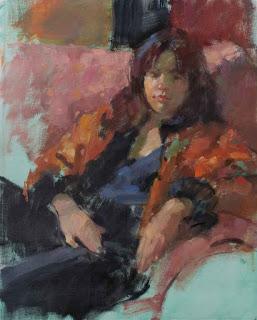
The Visitor
30 x 24"
Models are wonderful people that we treat like objects in the service of our art. We stare at them with an intensity that would get us slapped in the world outside our studios.
Good models calmly tolerate us as we squint, stare, measure with our outstretched brushes, and require them to hold poses for long stretches. Bad models act like we would in the same situation: twitching, sighing, and shifting about.
While some people truly aren't cut out to be models, they may also be pushed to fail by artists' insensitive behavior.
I've put together a list of things that I've found helpful for getting the most out of a model, and making him or her want to come back and work for you:
- Don't hurt them! Sounds obvious but I've seen models asked to hold tension-filled poses for hours and it's not fun for anyone. Make sure they have lumbar support in chairs, blocks under their heels to support a pointed-toe pose, and supports to take the weight off of hands and wrists in floor poses. The benefits of these ministrations are that your model will leave without needing bodywork, and you'll have seen her at her best throughout the session.
- Consider letting the model find his own pose within the parameters you set. You could ask for a seated pose in a certain chair then go and set up your materials, leaving the model to experiment with options. You'll find that he gives you a natural-looking pose that's unique to his body and personality, and it will probably be comfortable enough for him to sustain.
- Use your words, not your hands. Models have put themselves in exceptionally vulnerable positions for our art, and it's our responsibility to treat them like royalty. If their hair or limbs have shifted, explain to them what needs to be altered, but don't manipulate them yourself. Models tend to be young women who are often unsure of what they can ask or expect, and I find that they'll put up with bad behavior in order to keep the atmosphere pleasant, or out of insecurity. It helps to imagine the model's family, and treat her in a way that would make her mother happy.
- Give regular breaks. I'm guilty of going overtime on occasion, and I do, in fact, feel very guilty about it. It's hard to keep track of model breaks, and get yourself in the zone where you're painting freely and fluently. That's why I prefer the model to keep track of his own time using his phone set for 25 minute increments. When his timer rings, I don't beg for a few more minutes (though I always want to!)
- Communicate with the model. If she's shifting or flexing, chances are she's in pain. Ask how you can help her get comfortable in the pose and experiment with supporting pillows and alterations to the pose until she is. This may mean scrapping some of your work because the pose has proven impossible, but it's the right thing to do. The model shouldn't have to suffer for your art.
- Provide a portable heater. Even a clothed model will feel chilled because he's sitting too still to generate any heat. Nude models turn blue.
- Have the model fee ready and don't expect her to have change.
- Thank your model profusely. There are easier and less emotionally intense ways to make money than to pose - often nude - in front of a bunch of strangers. Remember the huge favour she's doing you, and thank her sincerely. If it weren't for her, you'd be stuck painting bowls of fruit.
Happy painting!
If you'd like to get my blog delivered to your inbox, please subscribe with your email address in the box on the right side of this page.

